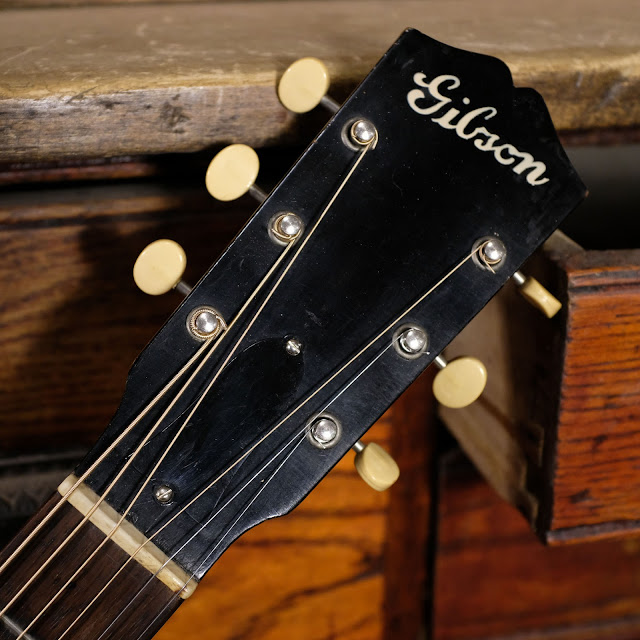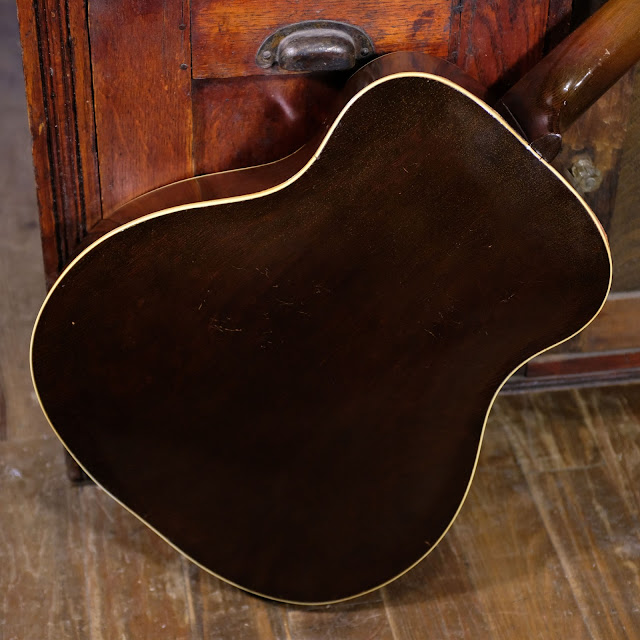1933 Gibson L-50 Carved-Top Round-Soundhole Guitar
Update June 2018: The owner of this guitar sent it back in for re-consignment. He has a number of Gibsons and switched to a KG-11 for the slot this box occupied. So, it's here again!
Gibson changed the L-50 model three times in three years. In '32 it looked roughly like this guitar (with a shallowly-carved top and glued-on pickguard) but had a sort-of mini-dreadnought shape. In '33 it was this guitar and featured a squashed-body, 00-size shape that's the same profile as a Kalamazoo KG-11. In 1934 the body shape changed again to the familiar, longer L-00 shape, though the rest of the design elements and bracing were more or less the same.
Gibson changed the L-50 model three times in three years. In '32 it looked roughly like this guitar (with a shallowly-carved top and glued-on pickguard) but had a sort-of mini-dreadnought shape. In '33 it was this guitar and featured a squashed-body, 00-size shape that's the same profile as a Kalamazoo KG-11. In 1934 the body shape changed again to the familiar, longer L-00 shape, though the rest of the design elements and bracing were more or less the same.
Frankly, I love these weird Gibson carved-tops for all of their idiosyncrasies. People look at these things and think something along the lines of, "Oh, it has a round soundhole, so it must sound like a flattop rather than that nasty archtop thing! And it looks cool!"
Well, cool it does look -- but it only sounds a little bit like a flattop when you strum cowboy chords or crosspick it. What it sounds more like is an excellent carved-top Gibson with a bit more of an open, sing-songy sound to the way the notes come out. It projects and punches as well as any 16" carved-top Gibson I've owned, but has a more folksy jangle to some of the lower-register notes and a bit more sweet sustain to its treble side. It's probably about as "gypsy-jazz" as a Gibson gets, to be honest, though you'd have to string it up with copper-wrapped strings to try that out for sure.
A consignor sent this guitar in and it came with its original (moldy) case, lots of Mona-Steel strings (it had a set on it when I unpacked it), and other random goodies. It's 100% original except for a bit of meat taken off of the bridge base's top and, amazingly, the only cracks are some tiny little side-creep things I'll show later-on. It looks beautiful, sounds hot to trot, and if you're at all into old country-blues fingerpicking, saucy period-style lead flatpicking, or chop-chord menacing as a rhythm player, this thing is totally for you. It's the kind of guitar I'd consider more as a band, jam, or "show" instrument as its voice is purely crafted to cut and sit in its own sonic spot. It's a joy to play old-fashioned music on, though, for sure.
Work included regluing back seams and loose binding (there's some binding creep and not perfectly-aligned seams on the back), a fret level/dress, compensation of the bridge topper, side dots install, and general cleaning and setup stuff. It's strung-up with 54w-12 gauges, the truss in the neck works perfectly and the neck is straight, and it plays spot-on with 3/32" EA and 1/16" DGBE action at the 12th fret and room for the saddle to adjust up and down. The frets are just a hair heftier than the usual mid-'30s Gibson stuff and they have plenty of life in them after the level/dress work.
Don't you love that sunburst? It's a nice yellow that fades to a dark red-brown at the edges. It's not totally black at the extremities.
This guitar has a carved spruce top with tonebar bracing -- though a ladder brace spans the two braces below the soundhole and above it -- making sort-of an H or tic-tac-toe pattern. Unlike later models, however, the central ladder brace does not extend to the sides beyond the braces and I think this has added to a warmer/sweeter overall tone because of that.
The original bone nut is 1 3/4" in width and the neck has a medium, soft-V profile and a ~12" radius to the board. The neck itself is mahogany and the board is rosewood. The headstock veneer is painted black and, yes, the truss cover is original.
The board was mostly-unplayed when this came in. There's some minor discoloration on it. Believe it or not, the original owner must've mostly played this Hawaiian-style as there was an extender nut in the case and a mark on the fretboard below the nut.
I adore the glued-on pickguard. It's so much more convenient than the rattly off-the-face ones we're used to on carved-tops.
The bridge is original and ebony. I took a bit of meat off of the base's top to allow for more adjustment room and I also notched the B/E string slots on the saddle/topper for better intonation.
The maple on the back and sides is finished in a deep red-brown. I should also mention, too, that the back is carved on this one, rather than flat as on the '34 model.
The tuners are lubed and work fine.
Don't you love those old-fashioned capo marks? Sigh.
The only break in the binding is here on the back.
Okay, here are the ugly spots. The back shrunk and expanded differently from the sides, so there are a few spots on the back/side seam that aren't the best. This little one (above) is one of them. These are all perfectly sound structurally, but aesthetically aren't the best. Still... they're not obvious.
Here's crept binding that I filled the bottom edge on near the endpin area.
Here's the top of it -- overhanging the edge a little. This is on the "knee" side so it's not something that stands-out or bothers at all. That's the worst of it.
The endpin, interestingly, had its original hole drilled at a slight angle. Oops! I left it that way.
Here's the factory order number.
Here's the label inside the soundhole.
This comes with a chip case.
This comes with a chip case.


























Comments